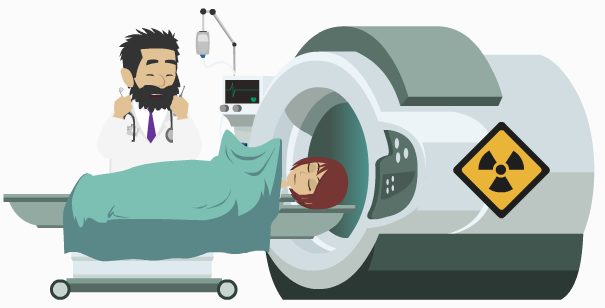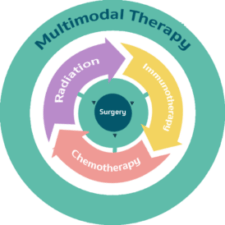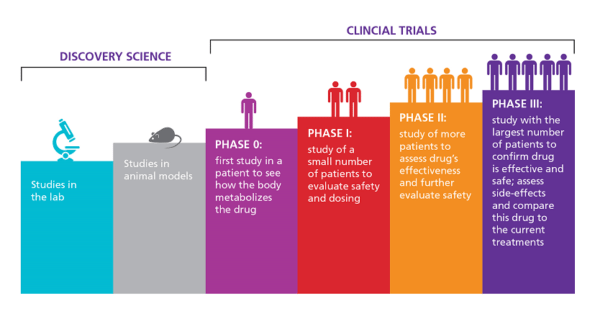
Mesothelioma Treatment Options
Once a person has been diagnosed with mesothelioma, the patient and doctor can begin to discuss all the mesothelioma treatment options available. There are three parent treatment options (chemotherapy, radiation, surgery), and any combination of the three results to what we know as, multimodal therapy. The mesothelioma treatment that will be administered to the patient will be decided on a couple factors such as,
The treatment that will be administered to the patient will be decided on a couple factors. These include:
- age of the patient
- the stage of mesothelioma
- overall health of the patient.
After the common mesothelioma treatments are understood, another topic that should be discussed is the inclusion and practice of alternative and complementary therapies. While these are not known for curing mesothelioma, they are known for minimizing pain, reducing stress, and improving a patient’s quality of life.
Which Would You Like To Learn First?

Traditional Mesothelioma Treatment

Chemotherapy:
Chemotherapy also known as systemic therapy, is administered either orally or by infusion to kill any cancer cells that are in the body, and there are a variety of medications. Although it is not curative it has proven to help increase the survival rate. Chemotherapy is also used to reduce pain and improve the patient’s quality of life.
- Kill mesothelioma cells
- Prevent cancerous cells from spreading
- Make other treatments more effective, such as surgery
- Shrink tumors
- Relieve pain

Radiation Therapy:
Radiation therapy is treatment that is used in combination with surgery and chemotherapy. Sometimes it is used alone to kill cancerous cells, manage tumors and it help to stop cancer from spreading along the path of the incision. Recent data shows that surgery, chemotherapy, and radiation together helps to kill cancer cells. Although oncologists have been using radiation treatment to help treat cancer for many years, technology has made it a more refined treatment. Click the button below to learn more about the pro’s and con’s of radiation therapy.

Surgery:
Traditionally, treatment for this serious and very aggressive cancer have been limited. More options have become available, some in the form of surgery. There are different types of surgery for mesothelioma and when surgery is recommended it is either for the purpose of curing the cancer, to relieve debilitating and painful symptoms of the disease, or to diagnose the cancer type and stage. Below are various surgery options that are used to treat mesothelioma.
- Pleurectomy / Decortication (P/D)
- Extrapleural Pneumonectomy (EPP)
- Cytoreduction / HIPEC
- Palliative Surgery

Multimodal Therapy:

Clinical Trials:
Studies of experimental or new therapies used on patients are known as clinical trials. Often doctors suggest that a patient participate in a clinical trial or new treatment if it is believed the patient may receive a positive outcome or other positive benefits from the trial. Clinical trials test groundbreaking research that have not yet been approved by the FDA and is still in a testing phase. On our clinical trials page, we will discuss,
- Clinical trial objectives
- Why choose clinical trials
- What clinical trials offers the patient
- Common concerns about clinical trials
- Recruitment specifications
- Participation guidelines
- Available clinical trials that are going on today.

S.M.A.R.T. Treatment For Mesothelioma
Surgery for Mesothelioma After Radiation Treatment
Is another multimodal approach to pleural mesothelioma. This approach can change how the disease is treated. Many studies have indicated that the combination of chemotherapy or radiation treatment with surgery has substantially increased the life expectancy of mesothelioma patients. Most multimodal treatments are treated with chemotherapy or radiation upon completion of surgery. SMART switches up the order and the results have been positive.
SMART is considered to be a potential breakthrough, however further research still needs to be conducted to determine if SMART can become a standard treatment for mesothelioma patients. Patients who undergo SMART treatment are living much longer.
Doctors who use the SMART approach simply reverse the two-step process. Usually, doctors treat the patient with chemotherapy or radiation after surgery has been completed. In this approach radiation therapy is administered prior to surgery.
Here’s How S.M.A.R.T. Works:
Intensity Modulated Radiation Therapy (IMRT)
First, a high dose of IMMRT is given to the patient. IMRT is a type of radiation that delivers different radiation levesl at the same time. Levels of radiation using the SMART approach are much higher than what is normally given. This is possible because the lung is removed soon after the radiation.
Extrapleural Pneumonectomy (EPP)
Patients are admitted for an EPP about 6 days after the radiation treatment. The surgeon removes the affected lung as well as the tissue surrounding it. It is hoped that future SMART approaches will lead to lung-sparing pleurectomies.

Cost For Mesothelioma Treatment:
Cancer treatment of any type is costly and planning ahead could help patients to avoid those unexpected expenses. When diagnosed with a serious disease, the cost of treatment and how that cost is going to be covered comes to mind quickly. If patients and families plan ahead, they can avoid being caught off guard by unexpected expenses.
Patients usually end up with more expenses than they expected because mesothelioma treatment can be extremely costly. These costs include medical costs as well as travel and caregiver expenses. Out of pocket expenses may include copayments, deductibles, and coinsurance. These are just some of the costs that patients must plan for.
Bringing up the cost of treatment to the doctor immediately will give patients a realistic expectation and allow them to take some type of immediate action to cover the treatment costs. Treatments can be paid for in several different ways. Sometimes patients have insurance and a savings they can utilize, but this might not be enough. You may also want to consider consulting with a mesothelioma law firm to help pay for treatment.

Researching ways to lower costs should be done right away. Some things that may help are charitable organizations and asbestos trust funds. Those exposed to asbestos may be entitled to financial compensation from the government or in case of exposure during the military, through Veterans Affairs.
The expenses of mesothelioma treatment vary with each individual patient and depends also on where they are in the treatment process. Specialists may have advice on how to manage the cost of treatment as well as direct patients to resources that could offer assistance.

Key Points To Remember & Consider
The traditional mesothelioma treatments listed above are the most common and recent studies have shown that if the patient is healthy enough to withstand all treatments as a multimodal treatment, a mesothelioma patient could see amazing results. The combination of these treatments have cured general forms of cancer before but nothing is guaranteed when it comes to asbestos-related cancers (asbestosis and mesothelioma). Another option to consider would be to sign up for clinical trials.
Clinical trials play a very important role when it comes to advancing mesothelioma research. They lead to the development of new, more effective mesothelioma treatments. Clinical trials provide mesothelioma treatment options that are currently unavailable to every patient. It is possible for a patient to participate in a clinical trial that will lead to their recovery. Some patients also add on complementary mesothelioma therapies like acupuncture, yoga, massage therapy, etc. Be sure to speak with a mesothelioma physician about the possibility of administering the traditional treatments along with complementary therapies.

Resources:
- Dodson, R. and Hammar, S. Asbestos: Risk Assessment, Epidemiology, and Health Effects. Taylor & Francis: Boca Raton. 2006.
- Pass, I., Vogelzang, N., Carbone, M. Malignant Mesothelioma: Advances in Pathogenesis, Diagnosis, and Transitional Therapies. Springer: New York. 2005.
- National Institutes of Health. (2012, June 5). Mesothelioma – malignant. Retrieved fromhttp://www.nlm.nih.gov/medlineplus/ency/article/000115.htm
- De Perrot, M., Feld, R., Cho, B.C. J., Bezjak, A., Anraku, M., et al.. Trimodality therapy with induction chemotherapy followed by extrapleural pneumonectomy and adjuvant high-dose hemithoracic radiation for malignant pleural mesothelioma. Retrieved fromhttp://jco.ascopubs.org/content/27/9/1413.abstract?ijkey=cc3963ea9a3a4bb5b4de2a5ed1215dfe6c125413&keytype2=tf_ipsecsha
- Munkholm-Larsen, S., Cao, C. Q., & Yan, T. D. (2009). Malignant pleural mesothelioma. Retrieved fromhttp://www.ncbi.nlm.nih.gov/pmc/articles/PMC2999110/?tool=pubmed
- Stahel, R.A., Weder, W., Lievens, Y., & Felip, E. (2010). Malignant pleural mesothelioma: ESMO Clinical Practice Guidelines for diagnosis, treatment and follow-up. Retrieved from http://annonc.oxfordjournals.org/content/21/suppl_5/v126.long
- National Comprehensive Cancer Network. (2012). National Comprehensive Cancer Network Clinical Practice Guidelines in Oncology: Malignant pleural mesothelioma. Version 2.2012.
- Campbell NP, Kindler HL. Update on malignant pleural mesothelioma. Semin Respir Crit Care Med. 2011;32(1):102-110.
- Sugarbaker, David, Zellos, Lambros S. Multimodality treatment of diffuse malignant pleural mesothelioma. Seminars in Onology. 2002; 29 (1): 41-50.
- Chua TC, Yan TD, Morris DL. Surgical biology for the clinician: peritoneal mesothelioma: current understanding and management. Can J Surg. 2009;52(1):59-64.
- Dodson, R. and Hammar, S. (2006). Asbestos: Risk Assessment, Epidemiology, and Health Effects Heidelberg. Springer Press
- Malignant mesothelioma treatment (PDQ). National Cancer Institute. Retrieved From:http://www.cancer.gov/cancertopics/pdq/treatment/malignantmesothelioma/patient. Retrieved on March 7, 2016.
- Types of treatment for mesothelioma by type.. Cancer Research UK. Retrieved From: http://www.cancerresearchuk.org/cancer-help/type/mesothelioma/treatment/types/. Accessed March 8, 2016.
Top 10 Best Mesothelioma Cancer Centers
Visit Them Now
Any medical or health advice provided and hosted on this site has been approved & edited by a team of registered nurses. The information provided on this site is designed to support, not replace, the relationship that exists between a patient/site visitor and the patient's/site visitor's physician. TreatMesothelioma.org pledges to respect the legal requirements for medical information confidentiality as well as all personal information, including identity. Our Disclaimer | Our Mission






